
bridwelli head & pronotum

transeolineae head

parisae head
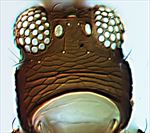
distinctus head
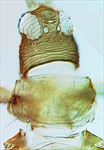
guizhouensis head & pronotum
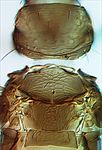
distinctus pro, meso & metanota

kwanzanensis pronotum

parisae pronotum
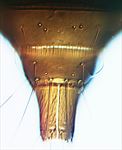
bridwelli tergites VIII-X
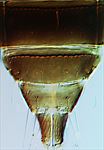
guizhouensis tergites VII-X
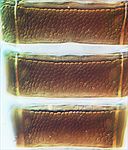
guizhouensis tergites V-VII
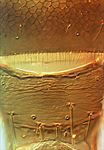
parisae male tergite IX
Generic diagnosis
Female macropterous or micropterous. Head longer than wide, constricted behind eyes; maxillary palps 3-segmented; eyes without pigmented facets; ocellar setae I absent; four pairs of postocular setae. Antennae 8-segmented, segment I without paired dorso-apical setae, III and IV with sense-cones forked, III–VI with some microtrichia on both surfaces. Pronotum wider than long; two pairs of long posteroangular setae and two pairs of posteromarginal setae. Mesonotum reticulate, median pair of setae situated near middle; campaniform sensilla present anteromedially. Metanotum reticulate; median setal pair behind anterior margin; campaniform sensilla present. Fore wing first and second veins with setal rows complete; clavus with five veinal and one discal setae; posterior fringe cilia wavy. Prosternal ferna not divided; basantra membranous, without setae; prospinasternum broad and transverse. Mesosternum without sternopleural sutures and without an endofurcal spinula. Metasternal endofurca without spinula. Tarsi 2-segmented. Tergites reticulate, without ctenidia or craspeda; VIII with complete posteromarginal comb; IX with two pairs of campanifom sensilla, MD setae present; X with median split complete. Sternites reticulate, III–VII with three pairs of posteromarginal setae arising slightly in front of margin; II with two pairs, VII with S1 and S2 far from margin; laterotergites without discal setae.
Male similar to female; sternites III–VIII each with oblong pore plate.
Biological data
The type species from North America is associated with leaves of certain Liliaceae and Orchidaceae, and two Asian species are known from species of Paris (Liliaceae), but the European species C. distinctus occurs on Convallaria majalis (Asparagaceae).
Distribution data
This genus is found widely around the Holarctic but, subsequent to the many synonymies established by Wang et al. (2020), only five species are currently recognised. The type species of the genus is from North America but is very similar to a species that is widespread across the northern Palaearctic.
Nomenclatural data
Ctenothrips Franklin, 1907: 247. Type species Ctenothrips bridwelli Franklin, 1907, by monotypy.
Only five species are now recognised in this genus, of which four are listed from China (Wang et al., 2020); a further eight species are placed into synonymy (ThripsWiki, 2020)
distinctus (Uzel, 1895: 121). (Physopus)
kwanzanensis Takahashi, 1937: 339.
parisae Wang et al., 2020: 313
transeolineae Chen, 1979: 184.
Relationship data
Thripidae sub-family Thripinae: this is a diverse group involving more than 230 genera. The species in Ctenothrips share several character states with some of the species of Taeniothrips, including picipes and major, such as the form and chaetotaxy of the head, a long comb on tergite VIII, and a strongly convex posterior margin to sternite VII in females with setae S1 and S2 distant from this margin. However, the tergites of Ctenothrips species have strong reticulate sculpture, the setal rows are almost complete on both longitudinal veins of the fore wing, and the mesothoracic furca is absent or only weakly indicated.
References
Tyagi K, Ghosh B & Kumar V (2014) The genus Ctenothrips from India (Thysanoptera: Thripidae) with description of one new species and one new record. Zootaxa 3821 (3): 273–279.
ThripsWiki (2020) ThripsWiki - providing information on the World's thrips. <http://thrips.info/wiki/Main_Page>
Wang ZH, Li YJ, Tong XL & Mound LA (2020) Phylogenetic analysis of the Taeniothrips genus-group, with revision of the species of Ctenothrips and Vulgatothrips (Thysanoptera, Thripinae). Zootaxa 4750 (3): 301–327.
Xie YH, Li YY & Zhang HR (2013) A new Leaf-feeding Thrips of Ctenothrips. Florida Entomologist, 96 (2): 609–618.